The Electric Telegraph stamps.
- Australia 1901-1988
- New South Wales
- Overview of NSW
- Telegraph lines
- Telegraph Offices
- Date stamps
- Forms
- Envelopes
- Instructional annotation
- Collect
- Delayed
- Free
- Immediate Urgent
- Reply paid
- Rates
- Stamps
- 1871 Telegraph stamps
- 1885 proposal
- 1893 proposal
- Queensland
- South Australia
- Tasmania
- Victoria
- Western Australia
- International
- Special aspects
There were three periods during which stamps could be used in New South Wales to prepay telegraph charges:
1. The 1871 issue of Telegraph Stamps.- lasted for about one month: the famous but rare Telegraph Stamps;
Background to the issue;
The artist's Essay for the design.
Printing the stamps.
The stamps issued.
Number of the stamps issued.
Specimen overprints.
Present stocks.
Multiples.
Used examples.
2. The 1885-1886 period authorising stamp usage;
3. The 1893 to Federation period.
The eight denominations (1d, 2d, 6d, 1/-, 2/-, 4/- 6/- and 8/-) reflected the rates which had been introduced in August 1870 - apart from the 6d which could be used as a make-up rate. Despite the notice saying that the stamps were to be available from 1 February, the stamps were sold in January.
 1d bright red and black. Perf 12.5. |
 2d light blue and black rejoined pair. Perf: 12.5. |
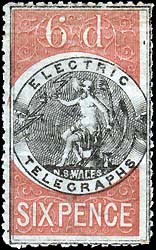 6d Indian red and black. Perf: 12.5. |
 1s pale blue and black. Perf: 12.5. Status Auctions April 2003 Lot 3123 had the 1/- with Plate No. 4 in right selvedge. |
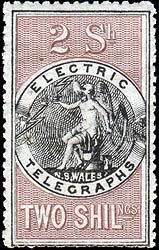 2s light brown and black. Perf: 12.5. |
 4s mauve and black. Perf: 12.5. |
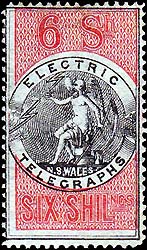 6s carmmine and black. Perf: 12.5. |
 8/- lilac and black. Perf 10. Poor centering and central vignette moved towards top left. |
In June 1871, 100 sets of the eight stamps were overprinted SPECIMEN in black Roman seriffed capital (13 x 1.5mm) letters. This overprinting was in accordance with the UPU agreements that member countries and postal authorities would distribute examples of their stamps to other members.
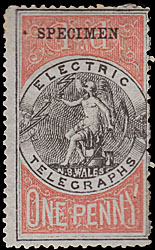 1d bright red. Perf: 12.5. |
 2d light blue. Perf: 12.5. |
 6d dull red. Perf: 12.5. |
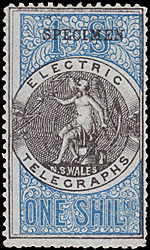 1/- blue. Perf: 12.5. |
 2/- light brown. Perf: 12.5. |
 4/- purple. Perf: 12.5. |
 6/- red rejoined pair. Perf 12.5. |
 8/- light mauve. Perf 12.5. |
An unknown number of the stamps now exist. Specimen stamps are probably scarcer than mint stamps and both types command high prices - especially the 6d and the 6/-. Unfortunately most stamps coming on the market are damaged with missing perfs, thins and tears or are showing the effects of rust.
There are probably less than 10 complete sets of the mint stamps and less than eight complete sets with the Specimen overprint.
Very few multiples are known and most are rejoined pairs. The recorded examples are:
 |
 |
Some genuinely used stamps are known with manuscript cancellations initialled in black pen across the stamps.
| No examples of the 1d. black and red have been recorded. | One example of the 2d. black and blue has been recorded. |
One example of the 2d. black and red has been recorded. |
One example of the 1/- black and blue has been recorded. |
|
 Used with a dominant H across the central figure. Prestige Philately May 2014 Lot 1352. |
 The mss annotation is now very faint due to the ink fading.
|
 Used with the mss extending through the H of SHIL. The mss annotation may be "OHMS". Provenance: Dave Elsmore. |
One example of the 4/- black Spink April 2017, Lot 2134. |
One example of the 6/- black and carmine Spink April 2017, Lot 2134. |
||
The lower perforations are not truncated. Spink April 2017, Lot 2134. |
 Used with the mss cancellation through the T of ELECTRIC. Provenance: Dave Elsmore. |
 Used with a date stamp in blue - which is unfortunately indecipherable. Ebay January 2023. |
| Three examples of the 8/- black and lilac used have been recorded. | ||
Telegraph forms printed early in 1871 (NC-TO-4) contained a column on the left headed "Please affix stamps in this space". Forms printed soon after did not have that space of course.


